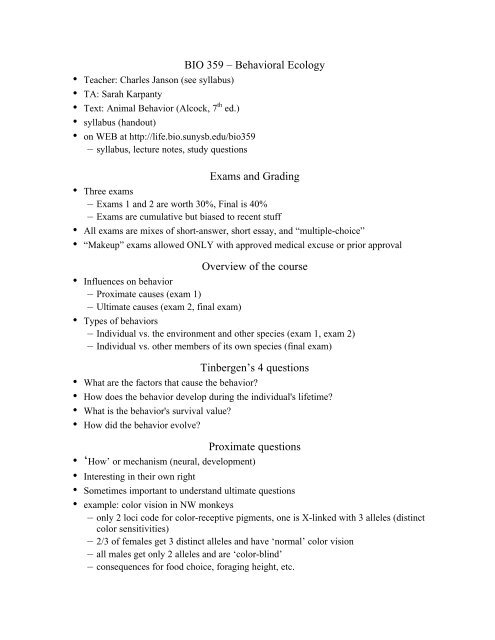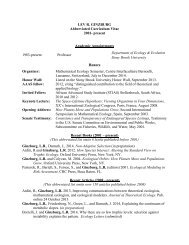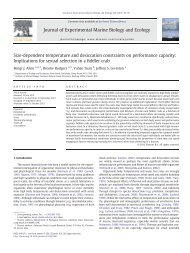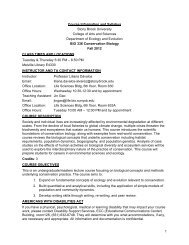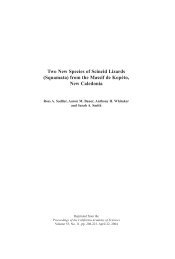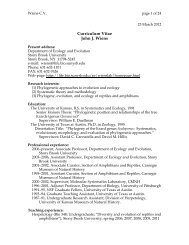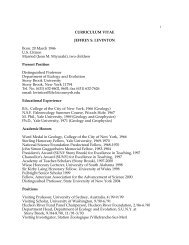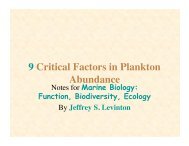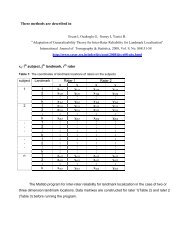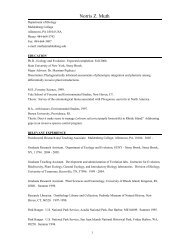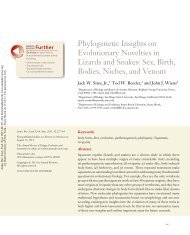Proximate versus Ultimate questions
Proximate versus Ultimate questions
Proximate versus Ultimate questions
Create successful ePaper yourself
Turn your PDF publications into a flip-book with our unique Google optimized e-Paper software.
BIO 359 – Behavioral Ecology<br />
• Teacher: Charles Janson (see syllabus)<br />
• TA: Sarah Karpanty<br />
• Text: Animal Behavior (Alcock, 7 th ed.)<br />
• syllabus (handout)<br />
• on WEB at http://life.bio.sunysb.edu/bio359<br />
– syllabus, lecture notes, study <strong>questions</strong><br />
Exams and Grading<br />
• Three exams<br />
– Exams 1 and 2 are worth 30%, Final is 40%<br />
– Exams are cumulative but biased to recent stuff<br />
• All exams are mixes of short-answer, short essay, and “multiple-choice”<br />
• “Makeup” exams allowed ONLY with approved medical excuse or prior approval<br />
Overview of the course<br />
• Influences on behavior<br />
– <strong>Proximate</strong> causes (exam 1)<br />
– <strong>Ultimate</strong> causes (exam 2, final exam)<br />
• Types of behaviors<br />
– Individual vs. the environment and other species (exam 1, exam 2)<br />
– Individual vs. other members of its own species (final exam)<br />
Tinbergen’s 4 <strong>questions</strong><br />
• What are the factors that cause the behavior?<br />
• How does the behavior develop during the individual's lifetime?<br />
• What is the behavior's survival value?<br />
• How did the behavior evolve?<br />
<strong>Proximate</strong> <strong>questions</strong><br />
• ‘How’ or mechanism (neural, development)<br />
• Interesting in their own right<br />
• Sometimes important to understand ultimate <strong>questions</strong><br />
• example: color vision in NW monkeys<br />
– only 2 loci code for color-receptive pigments, one is X-linked with 3 alleles (distinct<br />
color sensitivities)<br />
– 2/3 of females get 3 distinct alleles and have ‘normal’ color vision<br />
– all males get only 2 alleles and are ‘color-blind’<br />
– consequences for food choice, foraging height, etc.
<strong>Ultimate</strong> <strong>questions</strong><br />
• ‘Why’ = historical or functional<br />
– historical -- why is the trait this particular way rather than some other way that serves a<br />
similar purpose? Evolutionary history of genes.<br />
– functional -- what purpose does the behavior serve? What problem does it ‘solve’?<br />
– adaptive -- does it increase the fitness of those that use the behavior?<br />
Examples of <strong>Proximate</strong> and <strong>Ultimate</strong> <strong>questions</strong> from real organisms<br />
• Crested Owl. Nearly all owls hunt at night and many can capture prey<br />
in total darkness. <strong>Proximate</strong>: how do they do it? What neural circuits do<br />
they have to permit such hunting? Is this skill learned from parents or does<br />
it develop by individual practice alone? <strong>Ultimate</strong>: Does nocturnal hunting<br />
provide more food than daytime hunting? Are the prey species different?<br />
Does the owl make efficient choices about which prey to attack?<br />
• Golden Bamboo Lemur. This species, newly discovered to science<br />
about a decade ago by Dr. Patricia Wright of SUNY-SB, has a remarkable<br />
diet. It feeds primarily on bamboo shoots -- but these contain liberal<br />
amounts of cyanide!! <strong>Proximate</strong>: what cues does it use to decide which<br />
shoots to eat? How does it know when it has had enough of the potentially<br />
deadly shoots? <strong>Ultimate</strong>: How did it evolve the ability to eat these shoots?<br />
Why does it eat these rather than less poisonous species of bamboo shoots?<br />
• Golden Toad. This species (sadly, recently extinct: 1988), like many<br />
other toads, gathered from a solitary existence in the forest for a few days<br />
each year to mate in large numbers in a few ponds. <strong>Proximate</strong>: How did<br />
they know when and where to gather? How do they recognize members of<br />
their own species, especially of the opposite sex? <strong>Ultimate</strong>: Why gather to<br />
mate during only a few days? Do females choose to mate with males and do<br />
these choices increase the fitness of the females (and if so why?).


